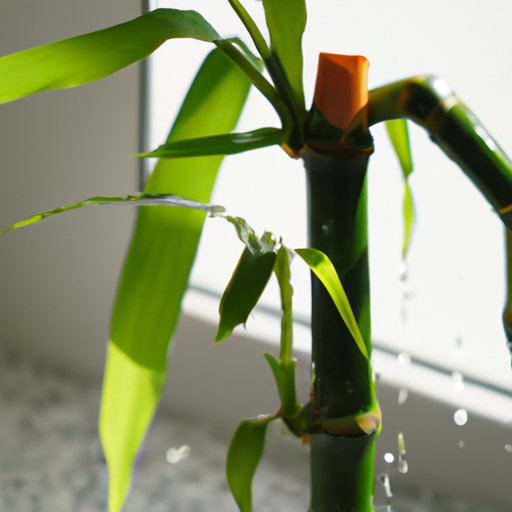Introduction
Bamboo plants are a beautiful addition to any home or office. They are relatively easy to care for, making them ideal for those who don’t have a lot of experience with houseplants. However, there are still important steps to take in order to ensure that your indoor bamboo plant thrives. In this article, we will explore how to properly care for indoor bamboo plants.
Choose the Right Pot and Soil
The first step in caring for your indoor bamboo plant is to select the right pot and soil. The type of pot you choose will depend on the size of your plant and the amount of space you have available. Smaller plants can be kept in shallow pots, while larger ones may require deeper pots. It’s also important to consider the material of the pot. Clay and ceramic pots are great for keeping moisture in, while plastic pots allow for better drainage.
When it comes to soil, you want to select something that is well-draining and nutrient-rich. Bamboo plants prefer a slightly acidic soil, so look for a potting mix that is formulated for acid-loving plants. Be sure to avoid soils that contain too much peat moss, as this can lead to root rot.
Water Properly
Bamboo plants need regular watering in order to stay healthy. How often you water will depend on the size of your plant and the type of pot you’re using. Generally speaking, you should water your bamboo every 7-10 days. Be sure not to overwater, as this can cause root rot. When you do water, make sure to water thoroughly so that the entire root system gets wet.
In terms of how much water to use, it’s best to use enough so that the soil is completely saturated. This helps to ensure that your plant is getting the moisture it needs without becoming overly wet. Allow the top inch or two of soil to dry out before watering again.
Provide Adequate Sunlight
Bamboo plants need plenty of sunlight in order to thrive. Many varieties prefer bright, indirect sunlight, such as that provided by south-facing windows. If you don’t have access to natural light, you may need to invest in a grow light in order to provide your bamboo with the light it needs.
It’s important to watch out for signs of too little light, such as yellowing leaves or stunted growth. If your plant is not receiving enough light, move it closer to a window or invest in a grow light.
Feed Regularly
Bamboo plants need to be fed regularly in order to stay healthy. The best way to do this is to use a balanced fertilizer, such as one designed for acid-loving plants. You can also use organic fertilizers such as fish emulsion or compost tea.
Be sure to follow the instructions on the fertilizer package and apply it at the recommended rate. You should fertilize your bamboo once every couple of months during the growing season, and once every 6-8 weeks during the winter.

Trim and Propagate as Needed
Trimming your bamboo plant is important in order to keep it looking its best. You should trim off any dead or dying leaves, as well as any branches that are growing in an undesirable direction. Trimming will also help to encourage new growth.
You can also propagate your bamboo plant by cutting off small shoots and planting them in separate containers. This will allow you to have multiple plants from just one original plant.
Combat Pests and Diseases
Bamboo plants can be susceptible to pests and diseases. Common pests include aphids, mealybugs, and spider mites. To combat these pests, you can use insecticidal soap, neem oil, or another natural pesticide.
Diseases can also affect bamboo plants, such as root rot and Fusarium wilt. To prevent these diseases, make sure to water your plants correctly and avoid overwatering. If your plant does become infected, you may need to discard it and start over with a new plant.
Monitor Temperature and Humidity
Bamboo plants prefer warm temperatures and moderate levels of humidity. The ideal temperature range for most types of bamboo is between 65 and 75 degrees Fahrenheit (18-24 degrees Celsius). Too much heat can cause the leaves to turn yellow, while too much cold can cause wilting.
Humidity levels should be kept in the 40-60% range. You can increase humidity levels by misting your plant with a spray bottle. If the humidity level in your home is naturally low, you may need to invest in a humidifier.
Conclusion
Indoor bamboo plants can be a beautiful and low-maintenance addition to your home. With the right care, they can continue to thrive for years to come. To care for your bamboo plant, make sure to choose the right pot and soil, water properly, provide adequate sunlight, feed regularly, trim and propagate as needed, combat pests and diseases, and monitor temperature and humidity.


